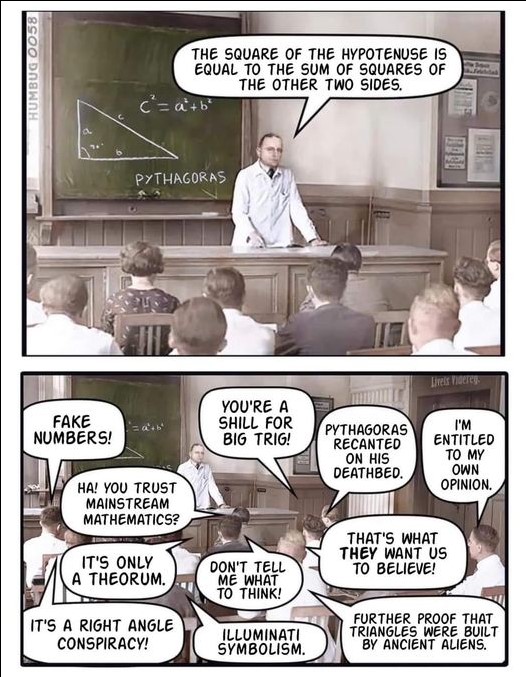- Phil Plait’s Under Alien Skies
- Jamie Green’s The Possibility of Life
- And a Facebook cartoon about the cynicism of anti-intellectuals

Phil Plait on John Scalzi’s blog today, about his new book Under Alien Skies: A Sightseer’s Guide to the Universe, a book about what the universe would look like from various vantage points.
As someone who quite often speaks to the public about astronomy, I get a lot of cosmic questions from people — honestly, mostly about black holes and aliens. But if I’m talking about specific astronomical objects, showing dazzling and mind-vaporizing Hubble or JWST images of nebulae or star clusters in a talk, for example, the question I hear the most generally falls under the category of, “Is this what it would look like if you were actually there?”
Good question, right? And while simple to ask, it’s deceptively hard to answer. The truth is, “No. Well, maybe. Sometimes. But not really. Kinda.” Worse, the more detail you try to give the harder this gets.
Obviously I’m ordering the book; I’m a fan of Plait, and I’m always fascinated by the challenge of appreciating the true size of the universe and how it would ‘look’ in reality, as opposed to the various depictions of stars and planets and galaxies in SF movies, virtually all of which are wrong.
\\

Slate, Jaime Green, 18 Apr 2023: I Wrote a Book About Aliens. But My Favorite Ones Lived on Earth., subtitled “A lesson in humanity, from the Neanderthals of Clan of the Cave Bear.”
The writer is author of a new book, which I’m also ordering, called The Possibility of Life: Science, Imagination, and Our Quest for Kinship in the Cosmos. Her approach is rather like my own: consider reality, compare and contrast with how SF has tried to depict it.
Writers love to have aliens tell humans how they see them: In Carl Sagan’s Contact, the alien says, “Love is very important [to humans]. You’re an interesting mix.” In Octavia Butler’s Dawn, it’s that humanity is “intelligent [and] hierarchical … It’s a terrestrial characteristic.” Aliens are more than a mirror, more than a foil; they’re sentient and can tell us what they see.
Auel’s Neanderthals see Ayla’s strange newness, too. Her antagonist unpacks his loathing of her: “The real problem was she was not Clan. She had not had subservience bred into her for untold generations.” (The Clan are not only small-c conservative, but echo the big-C kind, too, falling into rigid gender roles which Auel’s Homo sapiens eschew. Alien stories give us what their authors think we need, which in Auel’s case was, at least in part, feminism.) Ayla’s adopted father, the Clan’s holy man, sees the same difference, but with sorrow and love: “He could make no quantum leaps, no intuitive strokes of genius. His mind, he knew, was more powerful than hers by far; more intelligent perhaps. But his genius was of a different nature. … In her, he sensed the youth, the vitality of a newer form.”
My own thought, a while back, is how the “autism spectrum” is a range of ways human minds perceive and interact with reality. The common assumption is that there is one “right” way for people to think, and any deviation from this is a problem; thus so many people are freaked out about autism, while in fact many of the great geniuses throughout history would have been diagnosed today as autistic. The range of human thinking doesn’t have one perfect mode; that is part of the diversity of the human species. Science fiction writers for decades have tried to imagine how a true alien would think. Maybe the aliens are already here. Already with us, like that thin slice of exceptions to the most common atoms in the universe, three days ago, and the analogous thin slice of sexual and gender minorities.
\
Here’s another piece by Jaime Green, an excerpt from her new book, focusing on one SF novel in particular, which I reviewed for Black Gate here.

Jamie Green, The Atlantic, 17 Apr 2023: Why Does Contact Say So Much About God?, subtitled “Carl Sagan’s novel is an unexpected lesson in faith.”
At first thought, I find it extraordinarily strange that Contact, a book about the power of scientific inquiry as a source of awe and self-discovery, would end with proof that God is real. Not the God of Jesus or Abraham or anyone else, but some creator, some Star Maker who embedded a message in math. Ellie’s journey, though she is an atheist, is one of faith—her SETI research is motivated by a belief in something bigger beyond Earth; upon her return, she has no proof aside from experience of the journey.
Now I addressed the question of why Sagan ended his novel the way he did in my review. Green’s “unexpected lesson in faith” seems to be wishful thinking. As if when humans think about such things, they are stuck in a rut, and anything beyond everyday experience or understanding can be attributed to “faith” and “God,” which means whatever you want it to mean, and which inevitably conflates with Biblical miracles and personal answers to prayer. Sloppy thinking.
\\\
Finally, a photo from Facebook, about our current cynical, anti-intellectual age.






